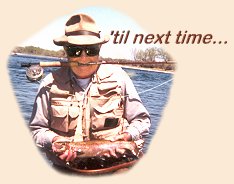
| ||
|
November 3rd, 2003
|
|
Q. From "bugs": Thank you for the information on the effects of flooding on fish. I enjoyed your article. I'm equally curious about how drought affects fish, especially in small streams. For example, in some streams when the water gets to a certain low level there may be very little flow in some stretches, accompanied by fewer pools and much shallower conditions in the pools that remain. During these occasions is the fish fatality rate higher, or are the fish just more crowded in water that's deep enough to sustain them? I expect there would be some effect on bait fish predation (an increase?) but I'm not sure how all the interaction works. Perhaps you could address this topic in a future article. Thanks again.
A.
You're pretty close on your observations, and it
doesn't take a drought to produce some of the
conditions you describe. Many small streams
exhibit these conditions as a normal part of
their hydrologic cycle in late summer and early
autumn.
As water levels decline, from drought or just
normal low flows, surface water decreases, often
to the point where the stream bed completely dries
up and open water is restricted to pools. As the
surface water decreases in area, fish (we'll discuss
invertebrates below) must retreat to these pools
or become stranded and die. In these pools, a
combination of detrimental events can occur, acting
in concert with each other. As the pools become
isolated, and if they are not fed by subsurface flows,
they become smaller and smaller as water evaporates
or percolates into the stream bed. This results in
two things happening: (1) the water warms up and can
potentially reach lethal temperatures, killing the
fish directly, and (2) as the water temperature
increases, the water becomes less capable of holding
dissolved oxygen, leading to oxygen levels too low
to sustain fish life. As water levels in these
refugia fall, the surviving fish also become more
susceptible to predation from two sources: (1) crowding
into a smaller and smaller volume of water increases
the chance of contact between carnivorous fish and
their prey, and (2) all fish become more vulnerable
to terrestrial predators such as osprey, eagles,
otters, raccoons, etc. Even if flowing water remains
between pools, low water levels enhance the ability
of predators to reach prey.
A word or two about invertebrates. They, too, cannot
escape death by dessication if the stream bed dries up
or the water reaches lethal temperatures. However,
they have one escape route not available to most
fish - some of them can follow the water level down
into the stream bed (called the hyporheos, meaning
"below flow") where underground flow usually remains,
thus providing livable, if not ideal, conditions
until surface flows return. Some fish can survive
these conditions if they can retreat into mud and
remain moist and cool.
As alluded to above, subsurface flows may keep pools
provided with water, preventing them from drying
completely; if the inflowing water is cool enough,
it also ameliorates the warming up of the water.
I hope this satisfies your inquiry.
~ C. E. (Bert) Cushing, aka Streamdoctor 105 W. Cherokee Dr. Estes Park, CO 80517 Phone: 970-577-1584 Email: streamdoctor@aol.com
|
| If you would like to comment on this or any other article please feel free to post your views on the FAOL Bulletin Board! |
[ HOME ]
[ Search ] [ Contact FAOL ] [ Media Kit ]
 The 'Stream Doctor' is a retired professional stream ecologist and
author, now living in the West and spending way too much time
fly-fishing. You are invited to submit questions relating to
anything stream related directly to him for use in this Q & A Feature
at
The 'Stream Doctor' is a retired professional stream ecologist and
author, now living in the West and spending way too much time
fly-fishing. You are invited to submit questions relating to
anything stream related directly to him for use in this Q & A Feature
at